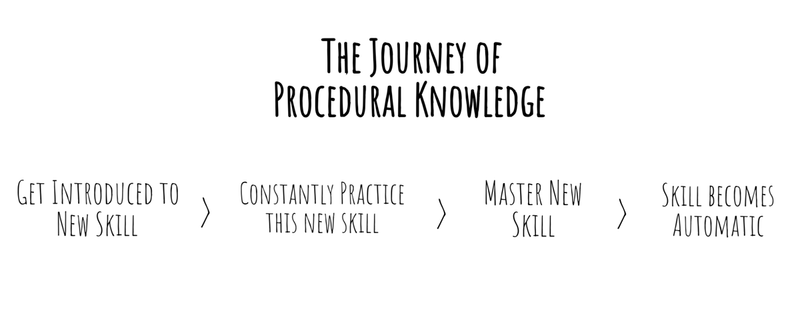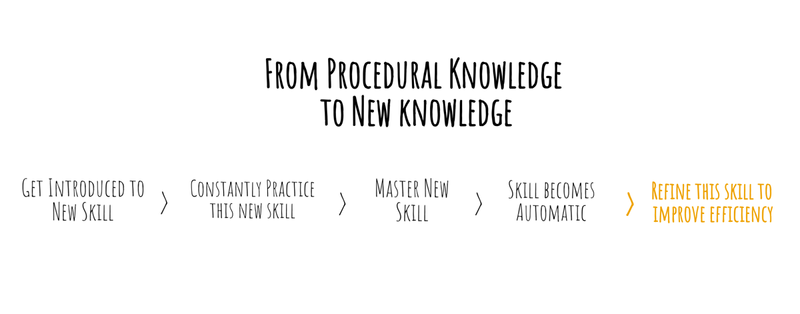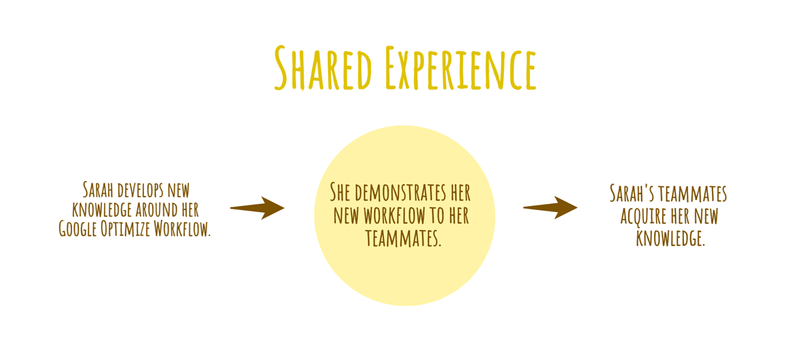From Procedural to New Knowledge: Leveraging Your Team’s Know-How
Your employees develop new and valuable knowledge after mastering a skill. Here’s how to help them share that knowledge with others.
Employees who master a job-related skill are incredibly valuable to their company.
They require little oversight when performing tasks tied to that skill — meaning they save their company time, money, and resources.
Procedural knowledge is at the core of this mastery.
What is procedural knowledge?
In cognitive psychology, procedural knowledge is the type of knowledge used when performing a task. You can think of it as know-how knowledge. “I know how to drive a car,” “I know how to bake a cake,” and “I know how to debug code” are all examples of procedural knowledge.
This differs from declarative knowledge, often referred to as know-that knowledge (“I know that the sky is blue,” “that rent is due on the 1st,” and “that my cat will randomly attack me today”).
You achieve procedural knowledge through the constant practice of a new skill — until that new skill becomes automatic.

For example, you give your employee, Sarah, a guide on running A/B tests with Google Optimize. She relies on that guide — and feedback from you — to run her first few tests.
After repeating the process a handful of times, she’s able to launch, monitor, and analyze A/B tests on her own. She’s developed procedural knowledge around this task; she can work independently.
How procedural knowledge leads to new knowledge
One limitation of procedural knowledge is that it represents what is, and not what can or will be. If Sarah never strayed from the Google Optimize guide she learned from, she would never optimize her skillset.
Fortunately, most employees who master a skill inevitably broaden their understanding of that skill and introduce new perspectives. They find ways to perform their task more effectively and efficiently.
For example, because Sarah mastered your team’s A/B process, she no longer needs that initial guide. More appropriately explained, she’s no longer limited by it. Her familiarity with the process allows her to broaden her understanding of this new skill. It’s only natural that over time she’ll refine her method to improve its efficiency.

Your team would likely benefit from these refinements — but at the moment, they remain personal to Sarah. And it’s fairly common for employees like Sarah not to share the personal knowledge they develop around a particular skill or task.
Knowledge hoarding is a possible cause, but the more likely culprit is that employees are often unable to see beyond their habits and customary practices.
They don’t realize they’ve created valuable knowledge worth sharing — so they don’t share it. This can create gaps in your knowledge management system.
Sarah wasn’t self-aware of changes she made in her approach. Most employees don’t have this self-awareness.
But self-awareness isn’t necessary for teams to leverage the knowledge employees create around specific skills or tasks.
What is necessary is creating an opportunity for shared experiences.
Using shared experiences to capture new knowledge
Documenting is arguably the most effective way to capture and share valuable knowledge. Writing requires you to think critically and clearly about your process.
However, some knowledge — like the personal knowledge people acquire after mastering a skill — can be challenging to document at first.
Shared experiences can help. They eliminate the friction associated with documenting one’s personal knowledge. They allow knowledge holders to demonstrate (or show) their knowledge before transferring it into words.
It might be easier, for example, for Sarah to first demonstrate her Google Optimize workflow to her teammates. Demonstrating her process allows her to walk through each step naturally, rather than pause to document. Also, by showing her process first, she’s less likely to gloss over steps she’s taken for granted.

The receivers of new knowledge also benefit from shared experiences. They can ask questions for clarification and request support when they’re stuck. They can also offer feedback and suggestions that refine the process even further.
Through this shared experience, both the receivers and knowledge holders can reach a consensus of the critical steps and language required to document this process so it’s replicable at scale.
Tip: Shared experiences don’t have to be synchronous. However, the most effective shared experiences for transferring knowledge allow the receivers to observe the task being performed and allow the knowledge holder to observe the receivers perform that task.
Creating shared experiences in your workplace
Creating shared experiences doesn’t have to be resource-intensive. You can integrate them into your team’s existing meeting rotation.
For example, if you hold a weekly scrum meeting, replace that meeting once every month with a show-and-tell session, where one employee demonstrates a specific task they perform, while her teammates observe and document the process.
This approach works best within teams (rather than across teams) because the audience will likely have a basic contextual foundation for better understanding.
Let’s use Sarah again to demonstrate how this show-and-tell session works.
Sarah showcases her A/B workflow to the rest of her growth team. Her teammates stop her when they’re confused, ask questions for clarification, and provide feedback.
During this process, one teammate — designated as the scribe — documents the steps Sarah showcases. The scribe’s goal is to create a running list of all the elements (and language) that the team agrees make this process replicable.
After the demonstration, the team reviews the scribe’s notes to fill any knowledge gaps and eliminate confusion.
By the end of the meeting, Sarah has the foundation for a procedural document that captures every critical step in her process in a format others can understand and replicate.
Leveraging the true value of procedural knowledge
Most teams know how to share existing knowledge — point someone to the procedural document that lives within your team wiki.
But growth doesn’t happen by limiting yourself to what is. Growth occurs when you tap into the new knowledge that employees develop after mastering a skill. However, employees alone can’t be expected to know how to identify and codify this new, personal knowledge. It takes a village, if you will.
By developing opportunities for shared experiences within your teams, you empower every employee to leverage the true value of your company’s existing procedural knowledge.

